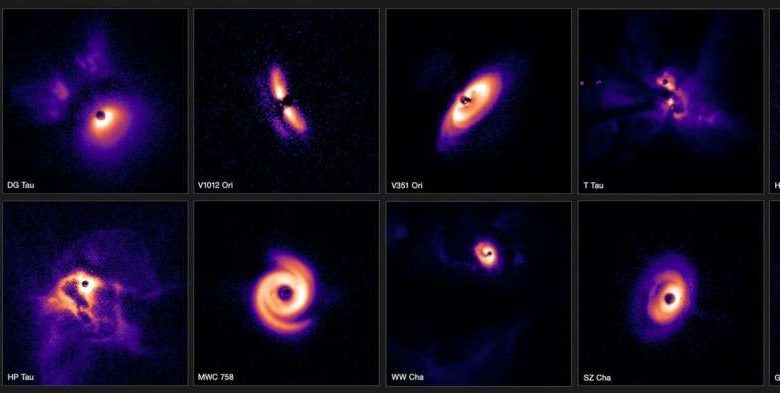Our survey of the sky is uncovering the secrets of how planets are born

When we look out to the stars, it is typically not a yearning for the distant depths of outer space that drives us. When we are looking out there, we are truly looking back at ourselves. We try to understand our place in the unimaginable vastness of the universe.
One of the most burning questions that drives us is how unique we are. Did life only emerge here on Earth or is our galaxy teaming with it?
The very first step in finding out is to understand how special the Earth really is—and, by extension, our entire solar system. This requires knowledge about how solar systems actually form. And that’s exactly what my colleagues and I have started to uncover with a new series of studies of star-forming regions.
In the past decades, astronomers have spotted more than 5,000 planets around distant stars—so called exoplanets. We now know that planets are so abundant that you can look up to almost any star in the night sky and be near certain that planets are circling around it. But what do these planets look like?
The first planet that was discovered around a star similar to the sun came as a shock to us. It was a so-called hot Jupiter, a massive gas giant that orbits its parent star on such a tight orbit that the length of a year is only four days. This is a truly alien world with no equal in our own solar system.
From this first groundbreaking discovery, astronomers have gone on and found tightly packed systems of super-Earths, rocky planets several times as massive as the Earth, as well as awesome gas giants in century-long orbits around their parent star. Of the many planetary systems that we have found, none equals our own solar system. In fact most of them are quite different.
To understand how all of these different systems come to be, we have to turn to the very beginning. And that’s majestic discs of dust and gas that surround the youngest stars. These are the nurseries which will eventually bring forth new planetary systems.
These discs are enormous objects, up to several hundred times as extended as the distance between the Earth and the sun. Yet in the sky they appear tiny. This is because even the nearest ones, which are practically in our galactic backyard, are between 600 and 1,600 light years away.
That is a tiny distance when you consider that the Milky Way galaxy has a diameter of more than 100,000 light years, but it still means that light, the fastest thing in the universe, takes up to 1,600 years to reach us from there.
The typical size of one of these planetary nurseries, as seen from the Earth, would be an angle of 1 “arc-second” on sky, which is equivalent to a 3,600th part of a degree. To put it in perspective, it is like trying to observe a person standing on top of the Eiffel Tower from 500km away in the Dutch capital of Amsterdam.
To observe these discs we need the most advanced and largest telescopes. And we need sophisticated instruments that can correct for atmospheric turbulence which blurs our images. This is no mean feat of engineering, with the latest generation of instruments only being available since about a decade.
New findings
Using the European Southern Observatory’s “Very Large Telescope”, the VLT, and the Sphere extreme adaptive optics camera, we have now started to survey nearby young stars.
Our team, consisting of scientists from more than ten countries was able to observe more than 80 of these young stars in amazing detail—with our findings published in a series of papers in the journal Astronomy and Astrophysics.
All the images were taken in near infrared light, invisible to the human eye. They show the light from the distant young stars as it is reflected from the tiny dust particles in the discs. This dust is much like sand on the beach and will eventually clump together to form new planets.
What we found was an astonishing diversity of shape and form of these planetary nurseries. Some of them have huge ring systems, others large spiral arms. Some of them are smooth and calm, and yet others are caught in the middle of a storm as dust and gas from the surrounding star-forming clouds rains down on them.
While we expected some of this diversity, our survey shows for the first time that this holds true even within the same star-forming regions. So even planetary systems that form within the same neighborhood might look quite different from one another.
Finding such wide range of discs suggests that the huge diversity in exoplanets discovered so far is a consequence of this broad spectrum of planetary nurseries.
Unlike the sun, most stars in our galaxy have companions, with two or more stars orbiting a shared center of mass. When looking at the constellation of Orion, we found that stars in groups of two or more were less likely to have large planet-forming discs than lone stars. This is a useful thing to know when hunting for exo-planets.
Another interesting finding was how uneven the discs in this region were, suggesting they may host massive planets that warp the discs.
The next step in our research will be to connect specific planets to their nurseries, to understand how the different systems might have formed in detail. We also want to zoom in even closer in the innermost regions of these discs in which terrestrial planets like our own Earth might already be forming.
For this, we will use the next generation of telescopes spearheaded by the “Extremely Large Telescope” of the European Southern Observatory that is right now under construction in the Chilean Atacama desert.
There are many questions to answer. But thanks to our survey we now know that the very first step on the long way for life to emerge is an utterly beautiful one.





